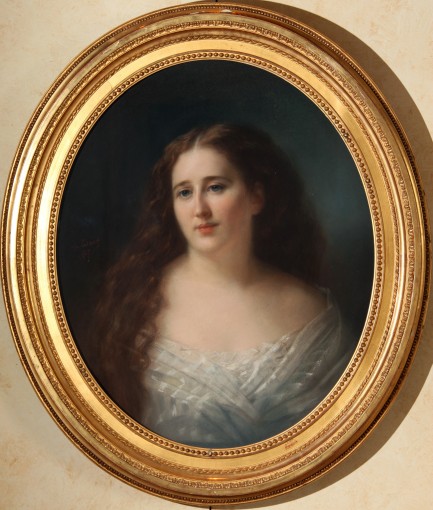
ROTHSCHILD Adèle de (EN)

Biographical article
Adèle de Rothschild was raised in Frankfurt am Main and was her cousin Salomon de Rothschild’s widow at a very young age in 1864. Throughout her life, Adèle gathered an important collection of artworks and books, a portion of which she had inherited from her father Mayer Carl de Rothschild, her husband, as well as her father-in-law James Mayer de Rothschild (1792-1868).
After Salomon’s death and a decade of semi-retirement, she built the hôtel de la rue Berryer (today the Fondation des Artistes) in Paris, where what was left of the Folie Beaujon was located (in 1882, Baroness Salomon de Rothschild enlarged her garden by having Balzac's house demolished, keeping only the columns of the Beaujon chapel). The work of the architect Léon Ohnet’s and his student Justin Ponsard created a link between the frame and the collected object. According to Pauline Prevost-Marcilhacy (2016), “This is a triple memorial dedicated to Balzac (the rotunda in Beaujon preserves several souvenirs of the writer), to her father Mayer Carl (whose gold and silver collections she installed on the first floor in 1895) and her husband. The cabinet of curiosities, isolated from the rest of the house, which Baroness Salomon had wanted to keep intact at the time of her bequest in 1922, plays the role of a sanctuary within this ensemble”. An album of 40 contact prints that had been commissioned for the inauguration from the photographer Gary in 1878 bear witness to the architecture and decoration of this hotel. These photographs were given to the Musée Carnavalet in 1891 along with the marquetry door of the room in Balzac's hotel (deposited in the Maison de Balzac in the 16th arrondissement of Paris).
Regarding Adèle’s collections, her expenditure seems to be very limited compared to that of her husband, judging by her account books (Prevost-Marcilhacy, 2016). The decoration of the hotel was inspired by that of the Château de Ferrières, notably the central hall, and by the craze for the 18th century, which had been made fashionable by the Empress Eugénie in 1860 at the Palais des Tuileries. Although considered outdated at the time, this type of decoration nevertheless accorded with her husband's taste. It is then in the most intimate rooms that Adèle revealed a more personal taste, such as in the bathroom in Japanese style, but also in the oriental garden pavilion or in the “oratory in Arabic style that was designed for religious ceremonies”. All of these spaces, which have now disappeared, adhered to the new oriental style, which reached its peak at the time of the Exposition universelle in 1878.
Adèle, who was dedicated to the development of the Musée des Arts Decoratifs, figured among the most prominent lenders for the first retrospective exhibition of the Union Centrale des Arts Décoratifs in 1865 and for the 1869 exhibition (Prevost-Marcilhacy, 2016). At her death in 1922, she bequeathed a selection of her collection to the Musée du Louvre, as well as nearly a thousand printed volumes, drawings, engravings, photographs and manuscripts at the Bibliothèque nationale de France. She also entrusted part of her works of art to the Musée de Cluny (some are now at Écouen) and at the Musée des Arts décoratifs in Paris. Her hôtel was finally bequeathed to the State, along with its park and outbuildings, so that it could be used "by the Beaux-Arts administration to create a house of art to be called the Salomon de Rothschild Foundation". Among the works of art that are still kept at the Fondation des Artistes are the Lion Embracing a Crocodile by Eugène Delacroix and the Orpheline alsacienne by Auguste Rodin.

The collection
At her death in 1922, Baroness Adèle de Rothchild donated her opulent collections to a number of French institutions. Her hôtel particulier at 11, rue Berrier in the 8th arrondissement was bequeathed to the State (Paze-Mazzi O., 2020, p. 55). Baroness de Rothchild’s will, written in 1908, announced that “The State shall preserve the Curiosity Room and its contents on the courtyard side in its present state, with its old coloured stained glass windows, as well as the Balzac Pavilion and its contents” (Paze-Mazzi O., 2020, P. 55).
Dispite its dispersal, Adèle and Salomon de Rothschild’s collection entered several Parisian institutions and offered a beautiful overview of this eclectic collection of manuscripts, 19th century Italian majolica, 18th century romantic paintings, ceramics but also Boulle clocks (Prévost-Marcilhacy P., 2016). Unfortunately, before his death, Adèle de Rothschild burned all of her archives, which makes it impossible to retrace and date her collection (Prévost-Marcilhacy P., 2016, p. 8-19).
The Rothschild hôtel particulier, although built and decorated in the 18th century style, nevertheless shows a certain desire for novelty, perhaps closer to the Baroness' personal taste, especially in the decoration of the bathroom, in the Japanese style, or through the oriental pavilion which adorns the garden (Prévost-Marcilhacy P., 2016, p. 8-19). The collection also includes some Chinese plates that are exhibited in the curiosities cabinet in the hotel de la rue Berryer. Furthermore, the Baroness was one of the largest lenders to retrospective exhibitions organised by the Union centrale des beaux-arts appliqués à l'industrie (Prévost-Marcilhacy P., 2016, p. 8-19).
Related articles
Collection / collection d'une personne
Personne / personne

